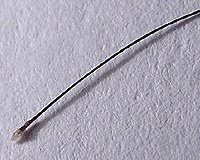| . |  |
. |
Miami FL (SPX) Jun 02, 2009 Ronald F. DeMeo, M.D., MBA, president of Radiation Shield Technologies (RST), has announced RST's introduction of the new Demron-W High Energy Nuclear/Ballistic IED RDD RED Shield, the world's first and only blanket that provides total protection against ballistics, improvised explosive devices, dirty bombs and all types of radiological and nuclear incidents. "RST's new Demron-W Nuclear/Ballistic Shield is the only device that enables our first responders and military to combat all threats faced today, including traditional ballistics and bombs as well as IED's, RDD's, RED's and the ever-increasing nuclear and radiological threats, road-side bombs that are triggered by cell phones," Dr. DeMeo said. "No other ballistic blanket currently provides significant protection against nuclear or radiological threats. Demron Shield provides unsurpassed nuclear suppression and outperforms all current soft-body armor in anti-fragment and ballistic protection. "The blankets also may be used to suppress all types of explosive devices and prevent catastrophes," Dr. DeMeo added. Edward Erickson, captain of Miami-Dade Fire Rescue's Hazardous Materials bureau, added: "Miami-Dade Fire Rescue is always looking for innovative ways to provide public safety. The high energy nuclear suppression blanket allows our team to maximize personal safety while minimizing economic impact." The flame- and acid-resistant shield is made with RST's patented Demron-W fabric, which has National Fire Protection Association (NFPA) Class 2 Certification for the 1994-2007 Standard on Protective Ensembles for First Responders to CBRN Terrorism Incidents. It proved in tests by H.P. White Laboratory to provide Level IIIA ballistic protection and unsurpassed fragmentation protection. Demron and the new Demron-W consist of a radiopaque nano-polymeric compound fused between layers of fabric and manufactured into several lightweight, nuclear-radiation blocking garments, including full-body suits, vests, blankets and medical X-ray vests and aprons. Demron has been proved to block gamma rays, X-rays and nuclear emissions by the Lawrence Livermore National Laboratory, part of the National Nuclear Security Administration within the U.S. Department of Energy, as well as the Georgia Institute of Technology and the Columbia University College of Physicians and Surgeons. Demron technologies are used worldwide by NATO, NASA, the National Guard, US Navy, UAE and the governments of South Korea, China, Saudi Arabia and Australia, among others. Scientists have selected it for future space travel. Share This Article With Planet Earth
Related Links Radiation Shield Technologies (RST) The Long War - Doctrine and Application
 Sulphur In Just One Hair Could Blow A Terrorist's Alibi
Sulphur In Just One Hair Could Blow A Terrorist's AlibiMadrid, Spain (SPX) May 29, 2009 A group of researchers from the LGC Chemical Metrology Laboratory in the United Kingdom and the University of Oviedo, Spain, have come up with a method to detect how the proportions of isotopes in a chemical element (atoms with an equal number of protons and electrons but different numbers of neutrons) vary throughout the length of a single hair. The mid-term objective is to be able to use ... read more |
|
| The content herein, unless otherwise known to be public domain, are Copyright 1995-2009 - SpaceDaily. AFP and UPI Wire Stories are copyright Agence France-Presse and United Press International. ESA Portal Reports are copyright European Space Agency. All NASA sourced material is public domain. Additional copyrights may apply in whole or part to other bona fide parties. Advertising does not imply endorsement,agreement or approval of any opinions, statements or information provided by SpaceDaily on any Web page published or hosted by SpaceDaily. Privacy Statement |